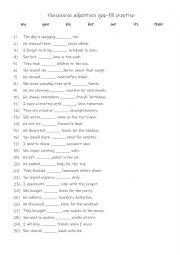
|
Possessive adjectives gap fill practise
Students read the sentence to identify the subject, then use the correctpossessive adjective to complete the gap fill. This worksheet is suitable for A1-A2 students. Answers on page 2.
Level: elementary
Age: 10-100
Type:
Downloads: 117
|
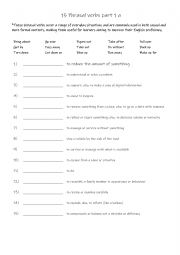
|
15 Phrasal verbs part 1 a
These phrasal verbs cover a range of everyday situations and are commonly used in both casual and more formal contexts, making them useful for learners aiming to improve their English proficiency; they are suitable for CEFR A2-B1 levels. Students match the phrasal verbs to their definitions. Answers on page 2. All of the phrasal verbs used in this ...
Level: elementary
Age: 10-100
Type: worksheet
Downloads: 117
|
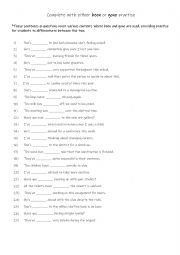
|
Complete with either been or gone practise
These sentences & questions cover various contexts where been and gone are used, providing practise for students to differentiate between the two. Students read the 27 sentences and questions to decide if the gap-fill exercise needs either been or gone to complete it. This worksheet is suitable for A2-B1 students. Answers on page 2.
Level: elementary
Age: 8-100
Type:
Downloads: 117
|
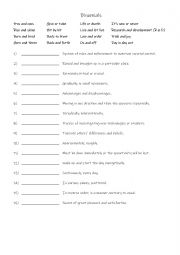
|
Binomials - common pairs of words 1b
Students read the definitions and match them with the correct pair of words.These pairs are often used for their rhythmic and memorable qualities, making the language more engaging and easier to remember.In English grammar, binomials are expressions where two words are joined by a conjunction (usually "and" or "or") to form a fixed phrase. These wo...
Level: intermediate
Age: 12-100
Type: worksheet
Downloads: 117
|
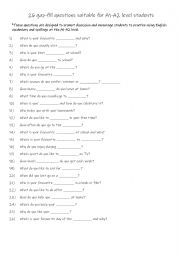
|
26 gap-fill questions suitable for A1-A2 level students
Students read the questions and complete them with a suitable word.Then after being checked; the worksheet should be used as a speaking reinforcement activity either in pairs or small groups. These questions are designed to prompt discussion and encourage students to practice using English vocabulary and spellings at A1-A2 level.
Level: elementary
Age: 8-100
Type: worksheet
Downloads: 117
|
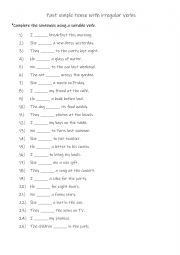
|
A1-A2 Past simple tense with irregular verbs
Students complete the sentences with a suitable irregular verb. Answers on page 2.
Level: elementary
Age: 8-100
Type: worksheet
Downloads: 117
|
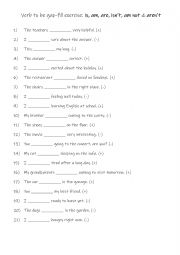
|
A1 Verb to be gap-fill exercise is, am, are, is not, am not & are not
This worksheet is suitable for starter to Elementary level. Students read the sentences, then complete the sentences using the correct form using the (+) or (-) clue at the end of each sentence. Answers on page 2
Level: elementary
Age: 8-100
Type:
Downloads: 117
|
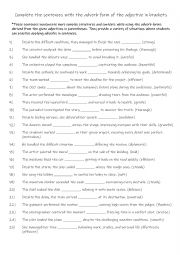
|
Practise with adverbs
Students complete the sentences with the adverb form of the adjective in brackets. These sentences incorporate more complex structures and contexts while using the adverb forms derived from the given adjectives in parentheses. They provide a variety of situations where students can practice applying adverbs in sentences. This worksheet is suitable ...
Level: intermediate
Age: 10-100
Type:
Downloads: 117
|
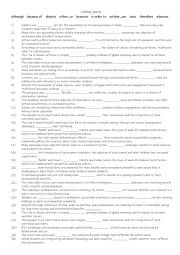
|
B2-C1 10 Linking words used in current trends - topics
These linkers help in clearly and precisely expressing relationships between ideas, making communication more effective. Learning them allows you to vary sentence structures, avoiding repetition and making your language more engaging and sophisticated. They are essential in constructing logical, coherent arguments in both written and spoken languag...
Level: advanced
Age: 12-100
Type:
Downloads: 117
|
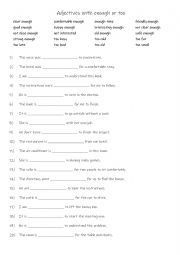
|
A1+- A2 Adjectives with enough or too
Students read the sentences, then complete the gap-fill with the logical choice in bold. After checking the answers this worksheet could be used as a speaking reinforcement activity for pairs or small groups. Answers on page 2.
Level: elementary
Age: 8-100
Type:
Downloads: 117
|












